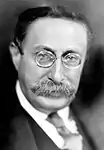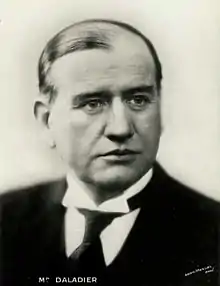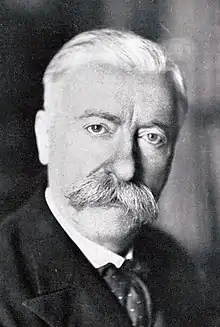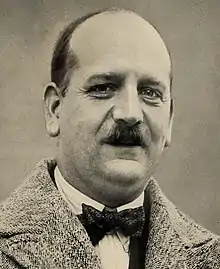1936 French legislative election
French legislative elections to elect the 16th legislature of the French Third Republic were held on 26 April and 3 May 1936. This was the last legislature of the Third Republic and the last election before World War II. The number of candidates set a record, with 4,807 people vying for 618 seats in the Chamber of Deputies. In the Seine Department alone, there were 1,402 candidates.[1]
| |||||||||||||||||||||||||||||||||||||||||||||||||||||||||||||||||||||||||||
All 610 seats to the Chamber of Deputies 306 seats were needed for a majority | |||||||||||||||||||||||||||||||||||||||||||||||||||||||||||||||||||||||||||
|---|---|---|---|---|---|---|---|---|---|---|---|---|---|---|---|---|---|---|---|---|---|---|---|---|---|---|---|---|---|---|---|---|---|---|---|---|---|---|---|---|---|---|---|---|---|---|---|---|---|---|---|---|---|---|---|---|---|---|---|---|---|---|---|---|---|---|---|---|---|---|---|---|---|---|---|
| Registered | 11,795,000 | ||||||||||||||||||||||||||||||||||||||||||||||||||||||||||||||||||||||||||
| Turnout | 9,847,266 (83.5%) | ||||||||||||||||||||||||||||||||||||||||||||||||||||||||||||||||||||||||||
| |||||||||||||||||||||||||||||||||||||||||||||||||||||||||||||||||||||||||||
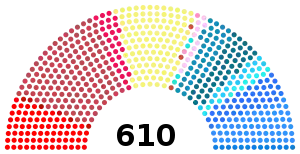 | |||||||||||||||||||||||||||||||||||||||||||||||||||||||||||||||||||||||||||
| |||||||||||||||||||||||||||||||||||||||||||||||||||||||||||||||||||||||||||
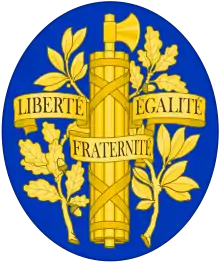 |
|---|
| This article is part of a series on the politics and government of France |
|
|
The Popular Front, composed of the French Section of the Workers' International (SFIO), the Radical-Socialists, the French Section of the Communist International (SFIC), and miscellaneous leftists, won power from the broad Republican coalitions that had governed since the 6 February 1934 crisis. Léon Blum became president of the council. Broad Republican coalitions had governed since the 6 February 1934 crisis: Government Gaston Doumergue II (Union Nationale, 272 days), Government Flandin I (204 days), Government Bouisson (3 days) and Government Laval IV (229 days).
For the first time, the Radical-Socialists were eclipsed on the left by the SFIO, while still keeping a considerable role in French politics.
Regional results
- The SFIC, predecessor of the Communist Party, doubled its score from 11 SFIC and 9 Union Ouvrière deputies in 1932 to 72 in 1936. The party made gains in industrialized suburbs and working-class areas of major cities. They also progressed in rural central and southwestern France (e.g., Dordogne, Lot-et-Garonne)
- The Radicals lost votes to the SFIO and SFIC, but also to the right.
- The SFIO declined slightly. In working-class suburbs, the party declined, but it gained votes in Brittany, to the dismay of the right.
- Only 174 seats were elected in the first round, 424 were decided in a run-off. The right fared better in the second round.
Results
Popular Vote
| Alliance | Votes | % | Party | Abbr. | Votes | % | ||
|---|---|---|---|---|---|---|---|---|
| Popular Front | 5,628,321 | 57.17 | French Section of the Workers' International (Section française de l'Internationale ouvrière) | SFIO | 1,955,306 | 19.86 | ||
| French Communist Party (Parti communiste français) | PCF | 1,502,404 | 15.26 | |||||
| Republican, Radical and Radical-Socialist Party (Parti républicain, radical et radical-socialiste) | PRRRS | 1,422,611 | 14.45 | |||||
| Miscellaneous Left (Divers gauche) | DVG | 748,600 | 7.60 | |||||
| Right and Centre | 4,202,298 | 42.68 | ||||||
| Democratic Alliance (Alliance démocratique), Independent Radicals (Radicaux indépendents), Popular Democrats (Démocrates populaires) | AD-RI-PDP | 2,536,294 | 25.76 | |||||
| Republican Federation (Fédération républicaine), Independents, Conservatives | FR | 1,666,004 | 16.92 | |||||
| Other parties | Div | 16,047 | 0.16 | |||||
| Total | 9,846,666 | 100 | ||||||
| Abstention: 17.75% | ||||||||
Parliamentary Groups
| Affiliation | Party | Seats | |
|---|---|---|---|
| Left | |||
| French Communist Party (PCF) | 72 | ||
| Party of Proletarian Unity (PUP) | 6 | ||
| French Section of the Workers' International (SFIO) | 149 | ||
| Socialist Republican Union (USR) | 29 | ||
| Centre-Left | |||
| Republican, Radical and Radical-Socialist Party (PRRRS) | 110 | ||
| Radical-Socialist Party Camille Pelletan (PRS-CP) | 3 | ||
| Frontist Party | 2 | ||
| Party of the Young Republic (PJR) | 4 | ||
| Independent Left | 11 | ||
| Centre-Right | |||
| Democratic and Independent Radical Left | 39 | ||
| Alliance of Left Republicans and Independent Radicals | 43 | ||
| Independents of Popular Action | 16 | ||
| Popular Democrats | 13 | ||
| Right | |||
| Independent Republicans of Social Action and Agrarian Group | 40 | ||
| Republican Federation and Independents of the National and Republican Union | 60 | ||
| Republican Independents | 13 | ||
| Total | 610 | ||
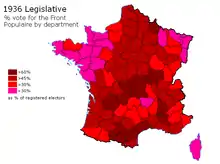
References
- "French elections a task for voters", The New York Times. 20 April 1936. Page 7.
- Results on France-politique.fr
- Parliamentary Groups on France-politique.fr
External links
